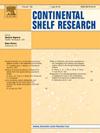Shift in the phytoplankton composition associated with reversal in east India coastal currents in the Bay of Bengal
IF 2.2
3区 地球科学
Q2 OCEANOGRAPHY
引用次数: 0
Abstract
The alteration of phytoplankton composition due to variations in physical mixing, salinity, nutrient concentrations and their stoichiometric ratios would impact the overall ecosystem, affect the food web and influence the carbon cycle. The seasonal reversal in the East Indian Coastal Currents (EICC) significantly modifies stratification, physical mixing and nutrient levels in the coastal waters. To examine the impact of reversal in EICC on nutrient stoichiometry and phytoplankton composition, coastal waters were measured at a monthly time scale in the inshore and offshore regions of the Bay of Bengal for one year. The EICC flows northward between February and September, bringing saline waters along the coast, associated with winds from the south-west direction, promotes coastal upwelling. Elevated concentrations of nutrients (nitrate, phosphate and silicate) and phytoplankton biomass were observed associated with coastal upwelling dominated by fucoxanthin (Bacillariophyceae), and chlorophyll-b (Chl-b; green algae). CHEMTAX analysis suggests that diatoms contributed significantly (60–70 %) during the upwelling period, with up to 90 % of the contribution coming from microplankton in both coastal and offshore regions. The EICC reverses its flow towards the south between October and January, bringing low saline, nutrient-poor waters along the coast, resulting in a decrease in Chlorophyll-a (Chl-a). During this period, the coastal waters were dominated by zeaxanthin (cyanobacteria). Despite nutrients not being limiting, picoplankton dominance during this period is caused by the transport of cyanobacteria from the river to the coastal region due to their abundance in the river water. The CHEMTAX analysis suggested that diatoms, prochlorophytes, and cyanobacteria contributed significantly in the inshore region, whereas chlorophytes and cyanobacteria contributed to the offshore region. Picoplankton (>50 %) contributed significantly, followed by micro (30 %) and nanoplankton (∼20 %). Fucoxanthin and Chl-b displayed a significant linear relationship with salinity, whereas zeaxanthin displayed an inverse relationship with salinity. The fraction of microplankton linearly correlated with salinity, whereas nano- and picoplankton inversely correlated. This study highlights the effect of temporal variabilities in salinity associated with reversing the EICC modified the phytoplankton composition, and it may have a significant impact on the coastal ecosystem. Understanding intra- and interannual variability in the EICC and associated salinity changes may allow for the prediction of phytoplankton composition in the coastal Bay of Bengal.
浮游植物组成的变化与孟加拉湾东印度沿海洋流的逆转有关
由于物理混合、盐度、营养物质浓度及其化学计量比的变化而引起的浮游植物组成的变化将影响整个生态系统,影响食物网并影响碳循环。东印度海岸海流(EICC)的季节逆转显著改变了沿海水域的分层、物理混合和营养水平。为了研究EICC逆转对营养化学计量学和浮游植物组成的影响,我们对孟加拉湾近岸和近海地区的沿海水域进行了为期一年的月度时间尺度测量。EICC在2月至9月期间向北流动,带来咸水沿海岸,与西南方向的风相结合,促进沿海上升流。观察到营养物(硝酸盐、磷酸盐和硅酸盐)和浮游植物生物量浓度的升高与以岩藻黄素(硅藻科)和叶绿素-b(绿藻)为主的沿海上升流有关。CHEMTAX分析表明,在上升流期间,硅藻的贡献显著(60 - 70%),其中高达90%的贡献来自沿海和近海地区的微型浮游生物。在10月至次年1月之间,EICC向南逆流,将沿岸低盐、贫营养的水体带来,导致叶绿素-a (Chl-a)减少。在此期间,沿海水域以玉米黄质(蓝藻)为主。尽管营养物质不受限制,但这一时期浮游生物的优势是由于河水中大量的蓝藻从河流输送到沿海地区造成的。CHEMTAX分析表明,硅藻、原绿藻和蓝藻在近海地区贡献显著,而绿藻和蓝藻在近海地区贡献显著。微浮游生物(> 50%)贡献显著,其次是微浮游生物(30%)和纳米浮游生物(约20%)。岩藻黄质和Chl-b与盐度呈显著的线性关系,玉米黄质与盐度呈负相关。微浮游生物的比例与盐度呈线性相关,而纳米浮游生物和微浮游生物的比例呈负相关。本研究强调了盐度的时间变化与EICC逆转相关的影响,改变了浮游植物的组成,并可能对沿海生态系统产生重大影响。了解EICC的年际和年际变化以及相关的盐度变化可能有助于预测孟加拉湾沿海的浮游植物组成。
本文章由计算机程序翻译,如有差异,请以英文原文为准。
求助全文
约1分钟内获得全文
求助全文
来源期刊

Continental Shelf Research
地学-海洋学
CiteScore
4.30
自引率
4.30%
发文量
136
审稿时长
6.1 months
期刊介绍:
Continental Shelf Research publishes articles dealing with the biological, chemical, geological and physical oceanography of the shallow marine environment, from coastal and estuarine waters out to the shelf break. The continental shelf is a critical environment within the land-ocean continuum, and many processes, functions and problems in the continental shelf are driven by terrestrial inputs transported through the rivers and estuaries to the coastal and continental shelf areas. Manuscripts that deal with these topics must make a clear link to the continental shelf. Examples of research areas include:
Physical sedimentology and geomorphology
Geochemistry of the coastal ocean (inorganic and organic)
Marine environment and anthropogenic effects
Interaction of physical dynamics with natural and manmade shoreline features
Benthic, phytoplankton and zooplankton ecology
Coastal water and sediment quality, and ecosystem health
Benthic-pelagic coupling (physical and biogeochemical)
Interactions between physical dynamics (waves, currents, mixing, etc.) and biogeochemical cycles
Estuarine, coastal and shelf sea modelling and process studies.
 求助内容:
求助内容: 应助结果提醒方式:
应助结果提醒方式:


